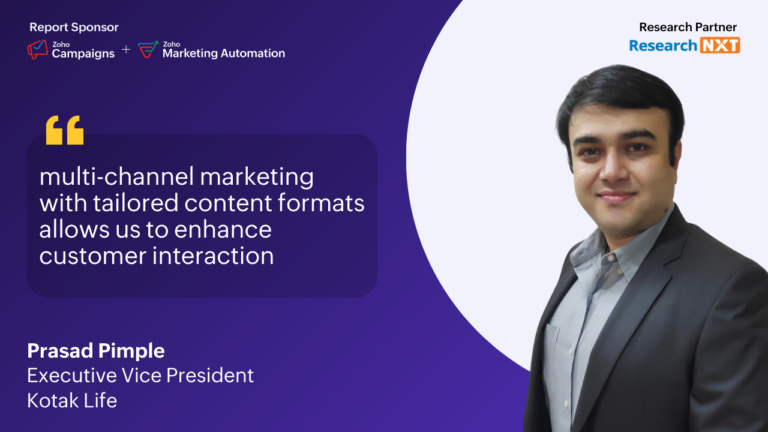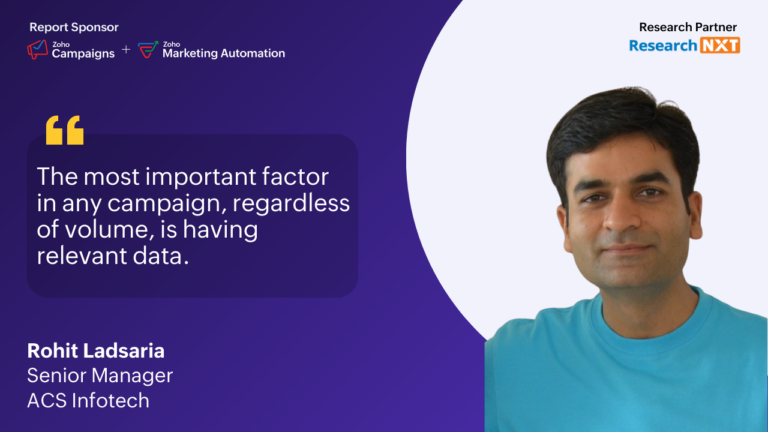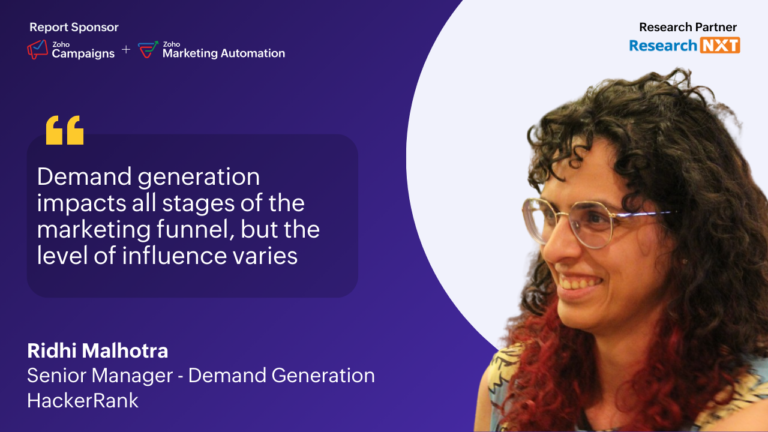
Driving B2B Marketing with Data, Automation, and Thought Leadership
In this interview with Research NXT, Ojas Kulkarni, Global Chief Marketing Officer at Cedar Consulting, shares insights on his career journey, emphasising customer-centric and data-driven marketing and being able to implement personalisation in about 60 strategies. He explains the evolving role of marketing automation in B2B, personalisation’s importance, and AI’s integration in content creation and campaign management. Ojas discusses the complexity of B2B buying journeys, the relevance of multi-touch attribution models, and the critical need for thoughtful content that resonates with target audiences. He also highlights the balance between AI-generated content and human creativity in driving engagement and success.
Key Takeaways:
- Ojas emphasises data-driven, customer-centric marketing approaches, viewing marketing as a science rather than an art.
- The ideal “unified customer view” in B2B marketing remains elusive due to complex buying processes involving multiple stakeholders.
- Automation remains crucial in B2B marketing, with 60-70% personalisation implementation boosting response rates.
- A multi-channel approach (online/offline) with consistent messaging is critical for B2B marketing success.
- Content strategy should demonstrate industry expertise, pain-point awareness, and solution provision.
- AI-generated content requires significant human editing and contextualisation for effective thought leadership.
- Campaign performance metrics should focus on input, output, and success metrics, and should be kept simple for each channel.
“The key to successful automation is being data-driven—understanding how to capture and interpret intent signals, and then building a sequence of actions based on this data.”
You have over two decades of experience across various marketing and business roles. How has your journey prepared you to lead marketing efforts in your current role? What are your core responsibilities, and how do you shape the firm’s global marketing strategy?
Ojas: My career has spanned various facets of the customer lifecycle—starting with customer service, and then moving through sales, business development, and marketing in the past 23 years. Throughout this journey, my approach has always been customer-centric and data-driven. While many in the industry have viewed marketing as more of an art, I’ve always seen it as a science—rooted in data, perception, and the customer’s needs.
For me, marketing is about understanding what the customer wants to hear, rather than just focusing on what we want to say. This mindset has been central to my love for marketing and has guided me through roles in operations, quality, and training. At Cedar, I align global marketing strategies with business goals, driving demand, brand awareness, and revenue growth.
I consider my experience to be full-stack marketing—everything from data collection and strategy building to executing email campaigns, digital marketing, and SEO. While younger marketers often lead newer trends, I remain focused on client acquisition and bringing a global perspective to the table. My passion for B2B marketing has shaped much of my professional journey, and it also drives my current research. I’m working on a doctoral thesis that explores the influence of marketing tactics on B2B buying decisions, which is a complex, non-linear process with multiple stakeholders. This research is an ongoing part of my work and continues to fuel my curiosity in the field.
How do you see the evolution of the unified customer view and 360-degree customer communication, especially in real-time interactions?
Ojas: Back in the day, Oracle introduced the concept of modern marketing, mapping out a maturity curve from basic branding and lead generation to a unified customer view. While I’ve always been a strong proponent of moving along that maturity curve, especially in B2B, I believe we’re not there yet. B2C has advanced significantly with automation in lead nurturing, segmentation, and campaign execution, thanks to tools like Zoho Campaigns, HubSpot, and Eloqua. However, the core function of automation—scaling personalised outreach and reducing manual processes—remains a challenge, particularly in B2B.
The buying journey in B2B is complex and nonlinear. Unlike B2C, where individual decisions are more straightforward, B2B purchasing involves multiple stakeholders with varying objectives and motivations. While automation tools streamline processes and personalise outreach, we’re still far from achieving a true 360-degree view of the customer. The challenge isn’t the tools’ limitations but the overwhelming amount of data and the need for marketers to determine what’s truly relevant in decision-making.
The rise of AI has accelerated this process, enabling faster integration and analysis of data through tools like large language models (LLMs). However, even with AI, the challenge lies in training these systems to deliver the right insights and tailoring the customer experience with a human touch. While AI is helping us move closer to that unified customer view, the journey is ongoing. In short, we’re not fully there yet, but AI is accelerating progress in ways we couldn’t have anticipated.
Read More
Having worked on various marketing automation initiatives across different organisations, especially in the B2B segment, how do you see the implementation of marketing automation differing in environments like KPOs and BPOs compared to research organisations and other sectors? How has marketing automation influenced the campaigns you’ve planned in these diverse settings?
Ojas: In my view, branding and demand generation operate as two distinct funnels, even though they may intersect at certain points. Branding is more about psychology and remains consistent, whereas demand generation has evolved significantly, particularly with the rise of automation. In sectors like BPO, KPO, or research-driven organisations, the core of marketing remains the same, but the approach to generating demand can differ based on the customer’s readiness to purchase services.
Automation has been a critical part of my work from the beginning, whether it was using basic tools like mail merge in Microsoft Office or leveraging more sophisticated platforms like Zoho, HubSpot, or Eloqua. Today, automation allows for the creation of highly personalised, dynamic content and campaigns, driven by data segmentation. By analysing data points such as industry, customer behaviour, engagement history, intent signals (like form fills or downloads), and even sales notes, automation can seamlessly guide prospects through the marketing funnel.
The key to successful automation is being data-driven—understanding how to capture and interpret intent signals, and then building a sequence of actions based on this data. Whether it’s segmenting audiences, personalising outreach, or integrating sales inputs into marketing automation systems, the result is higher engagement and improved conversion rates. In the past, sales development reps (SDRs) or business development reps (BDRs) manually gathered intent data and used it in their outreach. Now, automation does that work, tracking triggers and behaviours to guide potential customers towards a purchase decision.
Ultimately, automation simplifies the marketing process by reducing human effort while improving metrics like open rates, conversions, and overall engagement.
How do you incorporate personalisation into your digital campaigns? What tools or strategies do you use to ensure your marketing messages are tailored to individual client profiles?
Ojas: I’ve been able to implement personalisation in about 60-70% of my campaigns. The main elements I’ve personalised include names, cultural references, and region-specific nuances, which come from prior knowledge of the industry or person. When using dynamic content, I tailor the messaging based on intent signals. For instance, if someone downloads a white paper or research article on cybersecurity, I customise my follow-up with a relevant case study in that space, saying something like, ‘We did this for a client in the cybersecurity field, and I think you’ll find it interesting.’
The choice of words also matters whether it’s through email, LinkedIn, or other B2B channels. The personalisation extends to the individual’s intent, industry, regional context, and specific needs. While dynamic content hasn’t dramatically boosted conversion rates—still in the single digits—it has significantly improved open rates and initial response rates. In email marketing, even if the response is ‘I’m not interested right now,’ that’s still a success in terms of engagement, as it means the email worked, even if the timing wasn’t right for the prospect.
Overall, personalisation has been effective in driving engagement, though it’s not something I’ve managed to implement in every campaign, reaching around 60-70% of the time.
From a B2B perspective, which key channels have been most effective for you, and how do you ensure a seamless experience across them, especially in a consulting or KPO business where the focus is on building brand experience rather than direct online transactions?
Ojas: In a B2B context, email remains the strongest marketing channel, whether it’s for brand-building or demand generation. LinkedIn follows closely as a key platform where serious business professionals are active, whether for networking or seeking opportunities.
What works well is a mix of online and offline channels. Offline strategies include physical events and, surprisingly, direct mail—like sending postcards with QR codes that connect recipients to online resources, bridging offline and online engagement. Events, even small, close-knit gatherings of 20 people, provide valuable networking opportunities.
For online channels, apart from email and LinkedIn, video content has gained traction, with platforms like YouTube and Instagram playing a role in B2B marketing. Consistency across all channels—whether in copy, design, or messaging—is crucial. This old-school tactic of resonance, combined with the right mix of online and offline efforts, helps capture the attention of prospective customers and drive engagement.
What lead attribution models do you employ to understand the customer journey? Could you describe the stages in the lead attribution process and how you assign value to each touchpoint within your funnel?
Ojas: In B2B marketing, traditional attribution models like first-touch or last-touch no longer suffice. The decision-making process is now highly complex, resembling a “noodle soup” with multiple touchpoints across different channels. A multi-touch attribution model is more effective, where value is assigned to each interaction, from initial awareness to final conversion. The weight assigned to each touchpoint depends on factors like brand strength and the channel used, whether it’s online, offline, social media, paid ads, direct mail, email, or phone follow-ups.
For example, if out of 100 points, a lead reaches 60 points, it qualifies as a marketing-qualified lead (MQL), while 80 points could signal a sales-qualified lead (SQL). This model shows an uptick in the quality of inbound inquiries, even if the overall quantity could have decreased. Previously, 30 inquiries per month might result in only one relevant lead every 15 days. Now, even with just 5 inquiries a month, all of them could be strong leads, making them easier to follow up on and convert.
Given that you’re operating across multiple channels and your lead funnel is influenced by the processes you’ve set, how crucial is the right content for driving engagement? How do you differentiate between the types of content, such as thought leadership or advisory content, especially in a management consulting company? How do you determine which content resonates best with your audience?
Ojas: Creating effective content for a management consulting firm requires planning. The goal is to present the firm as a trusted advisor who understands industry pain points and offers credible solutions. Content must address several key areas: demonstrating trustworthiness, showcasing expertise in identifying pain points, and providing potential solutions based on industry knowledge or related experience. The final piece, a case study, shows a real-world application where the firm has successfully tackled a problem.
Content should span across these stages, from thought leadership pieces discussing broader industry challenges (e.g., blockchain implementation in banking) to granular content that dives into specific solutions. While you may not have solved every problem, knowing the industry and its challenges positions the firm as knowledgeable and reliable.
To maximise impact, content should be created in multiple formats, including case studies, infographics, blogs, and LinkedIn posts. A single comprehensive piece of content can also be repurposed into smaller, digestible formats to cater to different audience preferences and engagement levels. This approach ensures consistency in messaging while reaching audiences across various platforms and touchpoints.
Given the growing importance of AI, analytics, and automation in data management and personalisation, there’s still a critical need for human expertise, particularly in industries like ours where experience and specialised knowledge are key. What’s your perspective on the balance between AI-driven content and campaign management versus the human element? How are you currently integrating AI into your content strategy and campaign management, and where do you see its role evolving?
Ojas: That’s an interesting point, and I can sum it up with something I read in an article. While AI-generated content can be useful, the role of a good editor remains irreplaceable. The essence of that article was that no matter how advanced content generation tools become—whether it’s ChatGPT, Gemini, or any other AI—the human touch is essential to transform a draft into a phenomenal piece.
In the context of thought leadership and content marketing, we can leverage AI to create initial drafts, but it’s the knowledgeable editor who adds value by refining, contextualising, and ensuring the message is clear and on point. In my team, we do use AI-generated content, but never without reviewing and editing it to avoid repetition and ensure that it aligns with our intended message.
The challenge with AI-generated content is that while it processes vast amounts of data, it still lacks the human creativity and nuance required for perfection. That’s where the human element is irreplaceable, at least for now. I often use AI, like ChatGPT, to draft blogs, but I still find myself modifying 30-40% of the content before it’s ready for publication.
When managing campaigns, what metrics do you focus on to gauge their effectiveness? Could you provide examples of KPIs you use? How do these metrics inform your decision-making for future campaigns?
Ojas: There are three types of metrics that I focus on, keeping it simple but effective. First, are the input metrics, which track whether the required activities for a campaign have been executed. For instance, if the plan is to post three times a day, the input metric ensures that this is being done consistently—reviewed daily, weekly, or monthly.
Next are the output metrics, which measure the immediate results of these activities. Using LinkedIn as an example, the output metric would be how many likes, impressions, or engagements each post generated. For example, if the target is 20 likes per post, and you achieve that, you’re on track.
Finally, there are the success metrics, which focus on the broader impact. Did those posts lead to increased engagement and new followers, or help drive brand recognition? It’s not just about hitting a target for likes but understanding whether those interactions are translating into meaningful outcomes, such as lead generation or brand-building.
By focusing on these three clear areas—input, output, and success—and tailoring them per channel, you can maintain focus without getting overwhelmed by too many metrics. While it’s important to track multiple channels with these metrics, each has its own set of success indicators. For example, in email marketing, it’s crucial to measure how many emails were sent, how many were opened or clicked, and, ultimately, how many led to a meaningful response.
Before we wrap up, we want to know your expectations from this report. What do you think would be most valuable for the readers of the report?
Ojas: The key expectation I have from reports like these is that they provide insights into real-world applications, particularly in the B2B space where I’ve been working for over two decades. In B2B settings, challenges like long sales cycles and complex customer journeys are common. I’m looking for actionable takeaways—how specific strategies can be adapted, what key lessons can be drawn, and how common obstacles can be overcome. Practical examples of integrating marketing automation to address these challenges would be particularly valuable.






